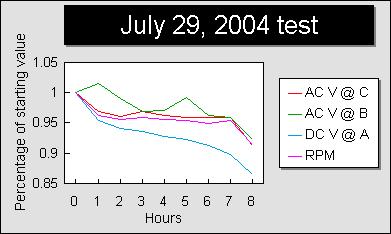The ground lead on channel one (the motor) was connected at point 4 and the other lead connected at point 3. (3,4) in my new scheme is called B. (1,2) is A and (5,6) I now call C. It's simpler to type and keep my notes with.
Sorry I wasn't clear about the July 29 test.
I kept hourly track of the readings at points A, B and C and the RPM. A gives the current battery voltage. B is between the coils and the 555 chip in the motor circuit and C is on the alternator circuit at the LED load. All the readings were made with a multimeter. The RPMs were made by tachometer.
Here are the readings for each hour.
July 29, 2004 test
Hour AC@ C AC@ B DC@ A RPM
- 1.54 1.31 5.42 985
- 1.49 1.33 5.17 948
- 1.48 1.30 5.10 942
- 1.49 1.27 5.07 945
- 1.48 1.27 5.03 942
- 1.48 1.30 5.00 939
- 1.48 1.26 4.95 935
- 1.48 1.26 4.87 940
- 1.41 1.21 4.69 900
avg 1.48 1.28 5.03 941.8
ten minutes later DC@ A was 4.4 volts. End of test.
Summary of Readings averages
At Volts Ohms Amps Watts
A 5.03 13700
B 1.28 1.4 .913 1.17
C 1.48 1.4 1.057 1.57
Power usage.
4 batteries @ 1800 mAhrs each total 7200 mAhrs
used for 8 hours or at the rate of 900 mA/hour MAX
Power provided by the free ride alternator coils.
Output at C=8 hours generated at 1057 mA/hr
For a total of 8459 mAhrs
117.49% efficiency
Here is a graph of the percentage declines from the start to the end.

The only capacitor in the system is related to the 555 chip and sure, all of the coils are inductors. But their very nature is that they store and release power and do not comprise a load, correct? So the only load on the input for the motor is in the resistors that control the 555 capacitor.
As far as determining the energy in, I have done that. It's the mAhr usage of the batteries, right?
They only thing I wanted to compare was an apples to apples situation. The mAhr calculation for the output at C is questionable to me, because I don't know for sure, if AC Volts and the Resistance of that circuit make amps that are directly comparable to the input amps of the batteries. If they are, then the efficiency measured should be valid.
Since I am using the maximum value of the battery discharge into the motor, then the only thing I might accomplish by trying to measure the minute energy of individual cycles would be greater efficiency, correct? Not that I'm adverse to doing those calculations, but since I know the maximum usage, all I need to do is find the total number of cycles over the eight hours and apply arithmetic to come up with the answer, right?
I had a couple of typos in the previous post about the points of measure. I hope this posts corrects those. Remember, the red trace in the scope image is channel two, measured at point C OF THE ALTERNATOR. The blue trace is channel one at point B of THE MOTOR.